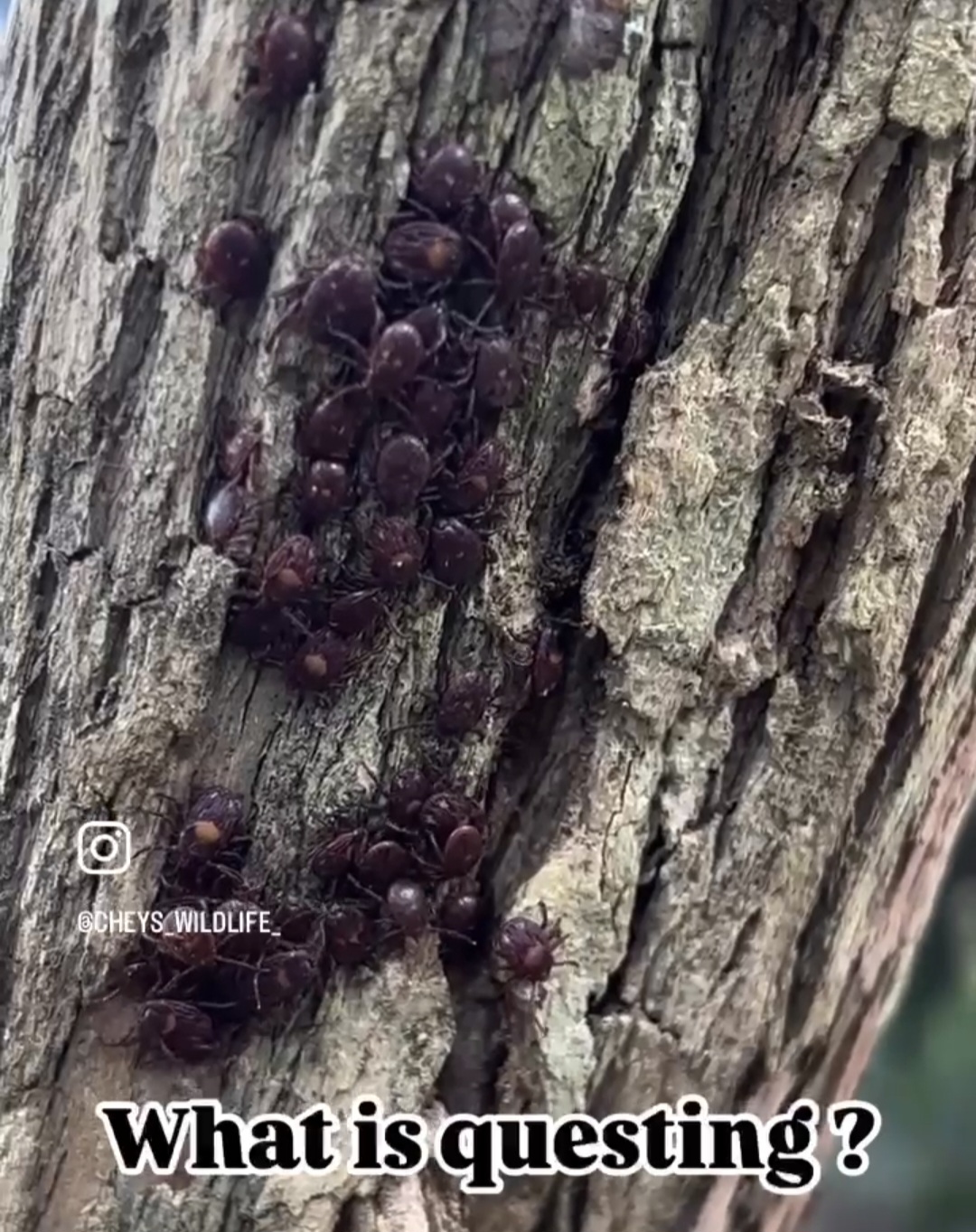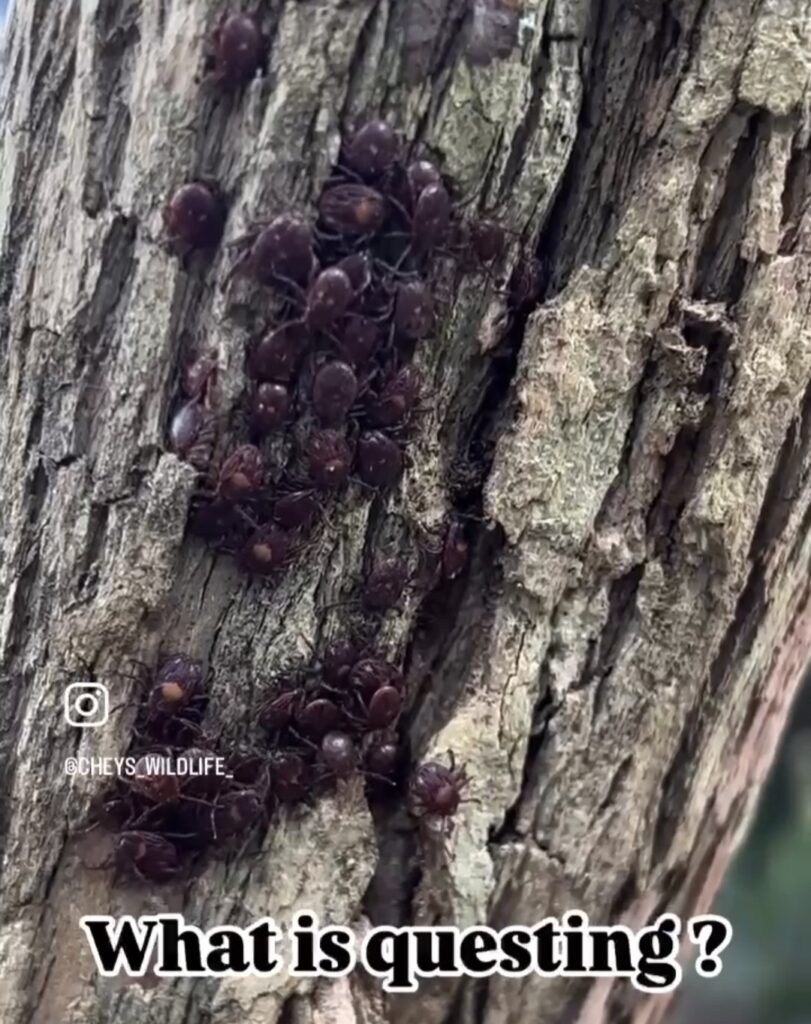Tick Questing Behavior
The Art of Questing: Understanding Tick Feeding and Animal Behavior with Nature Guide Cheyenne
Within the world of animal behavior, few phenomena are as captivating as the questing behavior of ticks. These tiny arachnids demonstrate a remarkable ability to detect hosts through their acute sensitivity to CO2, showcasing a sophisticated form of animal detection. In this blog post, we explore the world of tick feeding with insights from Cheyenne, a second-year Bhejane Nature Training, and FGASA Nature Guide.
Understanding the Art of Questing
Questing is an intriguing aspect of tick behavior, playing a crucial role in their survival and feeding habits.
Cheyenne explains:
When animals exhale, they release carbon monoxide (Co2). Ticks are highly sensitive to CO2, and use it to sense when a possible host is nearby.
In the video below, you will see me exhaling. This immediately gets the attention of the ticks. We can see them moving their front legs and grasping out in the hope that they will latch onto a host.
Watch the short video: Chey’s Wildlife on Instagram

Breathing Life into Tick Questing
Cheyenne’s demonstration of tick questing behavior involves breathing on a clump of ticks to activate them. This simple yet effective method showcases the ticks’ remarkable sensitivity to CO2.
By exhaling near the ticks, Cheyenne mimics the presence of a potential host. The ticks respond by becoming more active, extending their front legs, and preparing to latch onto a passing animal.
The Science Behind Questing
Questing is a behavior exhibited by ticks in order to help them locate and attach to potential hosts. This process involves ticks climbing to the tips of grass blades or leaves and extending their front legs, waiting for a suitable host to pass by for example.
The questing posture allows ticks to maximize their chances of encountering a host. They use their Haller’s organ, a sensory structure located on their front legs, to detect chemical and physical cues from potential hosts.
Ticks can remain in this questing position for extended periods. This is a good way for them to conserve energy until a host is detected. This patience and efficiency make ticks remarkably successful parasites in various ecosystems.
Role of CO2 in Animal Detection
Carbon dioxide (CO2) plays a pivotal role in how ticks detect potential hosts. Ticks are highly sensitive to CO2 concentrations, which serve as a reliable indicator of nearby breathing animals.
When an animal exhales, it releases CO2 into the surrounding air. Ticks can detect even slight increases in CO2 levels and this allowing them to identify the presence of a potential host long before visual contact is made.
This sensitivity to CO2 is so acute that ticks can differentiate between various animal species based on their respiration rates and CO2 output. This ability helps ticks target specific hosts that are most suitable for their feeding and life cycle needs, as noted in research on animal behavior.
Understanding Tick feeding behaviour
Ticks are obligate blood feeders. This means they require blood meals to complete their life cycle and reproduce. Similar to mosquitoes – they use a stealthy feeding strategy. This means they secrete anesthetic compounds in their saliva which making their bites painless and harder to detect.
Ticks are masters of stealth and this makes them efficient disease carriers.They can transmit various pathogens, including bacteria, viruses, and protozoa, which can cause diseases in their hosts. In Southern Africa the most common disease affecting humans is African Tick Bite Fever (Rickettsia africae). A common illness causing fever, headache, muscle pain, and a rash. It’s generally mild but can be uncomfortable.
Practical Tips for Field Guides
Ticks seek out humans just as much as any other mammal. Here are some practical tips for field guides and outdoor enthusiasts to help minimize tick encounters:
Wear appropriate clothing: Light-colored, long-sleeved shirts and pants tucked into socks make it easier to spot ticks.
Use natural repellents: Essential oils like eucalyptus or lemon can be effective tick deterrents. Ask your FGASA guide for tips on what local plants can be used to deter them.
Perform regular tick checks: Thoroughly inspect your body and clothing after spending time in tick-prone areas.
Leave your shoes outside your tent or room – and remove any visible ticks from your body before going near your bedding.
These tips, combined with an understanding of tick behavior, can significantly reduce the risk of tick bites and associated diseases or discomfort.
Learning with FGASA and Bhejane Nature Training
Bhejane Nature Training is a FGASA-endorsed training provider (The Field Guides Association of Southern Africa). Bhejane provides comprehensive training in wildlife ecology as part of our flagship 3-Year Advanced Nature Guiding and Wildlife Conservation Career Development Programme.
The courses cover topics such as animal behavior, habitat management, and conservation practices. This knowledge allows field guides to educate visitors about the intricate relationships between different species, including parasites and their hosts.
By integrating ecology into their training, Bhejane FGASA-certified guides like Cheyenne can provide visitors with a more comprehensive and engaging nature experience. This approach fosters a deeper appreciation for the complexity of natural systems and the importance of conservation efforts.
Learn more about the Bhejane Nature Training full time Career Development programmes available to young aspiring nature guides.
Download Career Development Programme info

Posted on: 27 May, 2025 by the Bhejane Tribe